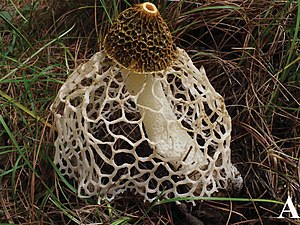Phallus haitangensis
| Phallus haitangensis | ||||||||||||
|---|---|---|---|---|---|---|---|---|---|---|---|---|

Ripe fruiting body of Phallus haitangensis |
||||||||||||
| Systematics | ||||||||||||
|
||||||||||||
| Scientific name | ||||||||||||
| Phallus haitangensis | ||||||||||||
| HL Li , JC Xu & KD Hyde |
Phallus haitangensis is a type of mushroom from the family of stinkhorn relatives thatoccursin the Chinese province of Yunnan .
features

Macroscopic features
The fruiting body of Phallus haitangensis develops like all generic representatives from a witch's egg . When fully grown, it is 130 to 165 mm high, unbranched and foul-smelling. The handle is hollow and chambered. Below the receptaculum , i.e. the part carrying the fruit layer , there is a so-called indusium , a kind of veil. The receptacle is up to 30–35 mm high and 24–50 mm wide, heavily reticulated, bell-shaped to umbrella-shaped and from dark orange to golden yellow in color. The edge is slightly curved upwards. The ridges are golden yellow. The gleba is sticky and sits in the dimples between the ridges. At the top of the hat (receptaculum) there is a clear hole 1–8 mm in diameter. The stem (pseudo-stem) is creamy white, 100-132 mm high and 8-11 mm at the tip, 15-20 mm in the middle and 18-22 mm wide at the base. It is fragile or soft, spongy with holes 1-10 mm in diameter. The pale to light orange, well-developed indusium is 85–95 mm long and 80–155 mm wide, the holes are almost round to polygonal, 4–35 mm in diameter and 1–4 mm thick. The volva is located at the base of the stem, is 30–140 mm high and 20–45 mm thick, yellowish white and smooth. It is rooted in the ground with a pinkish-whitish rhizomorph .
Microscopic features
The elliptical to cylindrical spores are 2.8–4.2 μm long and 1.1–2.6 μm wide, hyaline and smooth. The cells of the stalk measure 15–38.8 µm in diameter, are vesicular or foam-like, hyaline and smooth. The cells of the indusium are similar, measuring 21.2–41.6 μm in diameter. The hyphae of the volva are 1.8–3.8 μm wide, tubular and branched. The septa have buckles .
Ecology and diffusion
Phallus haitangensis is only known from the first description. It grew solitary or scattered on plant litter under Armand's pines . The species was found in Baoshan , Haitang Village in Yunnan Province at over 2000 m above sea level. As with all stinker morels, the spores are probably spread by insects, which are attracted by the smell and ingested by the gleba .
Origin of name
Due to its shape, the genus was given the scientific name phallus , and the specific epithet was given after the site in Haitang.
Systematics
Phallus haitangensis was first described by Huili Li , Jianchu Xu, and Kevin D. Hyde in the journal Phytotaxa in 2016 . According to a phylogenetic analysis, it is closely related to Phallus serrata and Pallus mengsongensis , even if the latter species has no indusium.
swell
Individual evidence
- ↑ a b c d e H. Li, X. Ma, PE Mortimer, CSC Karunarathna, J. Xu, KD Hyde: Phallus haitangensis , a new species of stinkhorn from Yunnan Province, China . In: Phytotaxa . tape 280 , 2016, p. 116-128 , doi : 10.11646 / phytotaxa.280.2.2 ( online ).
- ^ Hanns Kreisel : A preliminary survey of the genus Phallus sensu lato . In: Czech Mycology . tape 48 , 1996, pp. 273-81 ( pdf ).